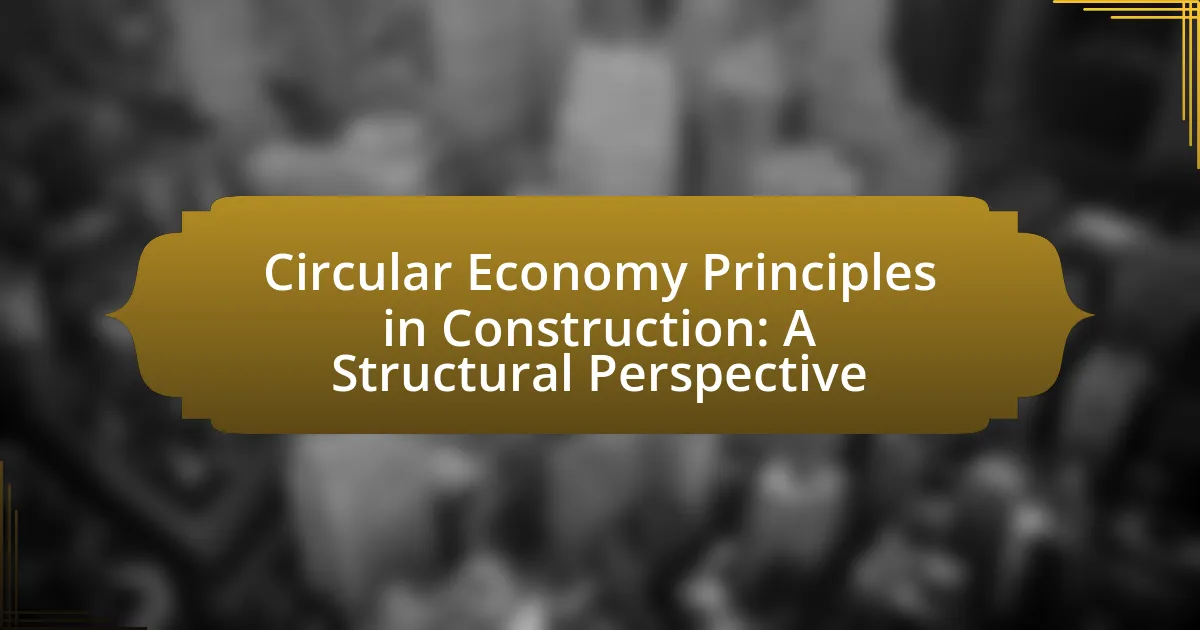The article focuses on the Circular Economy Principles in Construction, which aim to minimize waste and maximize resource efficiency throughout the lifecycle of buildings and infrastructure. Key components include designing for longevity, using renewable materials, promoting reuse and recycling, and implementing closed-loop systems. The article contrasts these principles with traditional construction practices, highlighting the significant environmental impacts of the construction industry, such as resource depletion and pollution. It also discusses the structural implications of adopting circular economy principles, the role of stakeholders, and the importance of innovation and policy in advancing sustainable practices within the sector.

What are the Circular Economy Principles in Construction?
The Circular Economy Principles in Construction focus on minimizing waste and maximizing resource efficiency throughout the lifecycle of buildings and infrastructure. These principles include designing for longevity, using renewable materials, promoting reuse and recycling, and implementing closed-loop systems. For instance, the Ellen MacArthur Foundation emphasizes that adopting these principles can lead to significant reductions in carbon emissions and resource consumption, with studies indicating that circular practices can reduce material costs by up to 30%.
How do these principles differ from traditional construction practices?
Circular economy principles in construction differ from traditional practices by emphasizing resource efficiency, waste reduction, and lifecycle thinking. Traditional construction often follows a linear model, where materials are extracted, used, and disposed of, leading to significant waste and environmental impact. In contrast, circular economy principles advocate for reusing materials, designing for disassembly, and minimizing resource consumption throughout the building’s lifecycle. For example, the Ellen MacArthur Foundation highlights that adopting circular practices can reduce construction waste by up to 80%, demonstrating a substantial shift in approach compared to conventional methods.
What are the key components of circular economy principles in construction?
The key components of circular economy principles in construction include resource efficiency, waste reduction, and lifecycle thinking. Resource efficiency focuses on minimizing the use of materials and energy throughout the construction process, ensuring that resources are utilized optimally. Waste reduction emphasizes designing buildings and infrastructure to minimize waste generation, promoting reuse and recycling of materials. Lifecycle thinking involves considering the entire lifecycle of a building, from design and construction to operation and eventual deconstruction, ensuring that materials can be reclaimed and repurposed. These components collectively aim to create a sustainable construction industry that reduces environmental impact and promotes economic viability.
How do these components contribute to sustainability in construction?
Components such as recycled materials, modular design, and energy-efficient systems significantly contribute to sustainability in construction by minimizing waste, reducing resource consumption, and enhancing energy performance. Recycled materials, for instance, lower the demand for virgin resources, thereby decreasing environmental impact; studies show that using recycled aggregates can reduce carbon emissions by up to 30%. Modular design promotes efficient use of materials and allows for easier disassembly and reuse, which aligns with circular economy principles. Energy-efficient systems, including renewable energy sources and smart technologies, reduce operational energy consumption, contributing to lower greenhouse gas emissions. Collectively, these components foster a sustainable construction approach that conserves resources and mitigates environmental harm.
Why is the circular economy important for the construction industry?
The circular economy is important for the construction industry because it promotes resource efficiency and waste reduction, leading to sustainable practices. By adopting circular economy principles, the construction sector can minimize material consumption and reduce landfill waste, which is critical given that construction and demolition activities account for approximately 30% of global waste. Furthermore, implementing circular strategies can lower costs associated with raw material procurement and waste disposal, while also enhancing the industry’s resilience against resource scarcity. This shift not only supports environmental sustainability but also aligns with regulatory trends favoring sustainable development, making it essential for the industry’s future viability.
What environmental impacts does the construction industry have?
The construction industry has significant environmental impacts, including resource depletion, habitat destruction, and pollution. Resource depletion occurs as the industry consumes vast amounts of raw materials, such as timber, minerals, and water, leading to the exhaustion of natural resources. Habitat destruction results from land clearing and site preparation, which disrupts ecosystems and threatens biodiversity. Pollution arises from construction activities that emit greenhouse gases, generate waste, and contaminate air and water. For instance, the construction sector is responsible for approximately 39% of global carbon emissions, highlighting its substantial contribution to climate change.
How can circular economy principles mitigate these impacts?
Circular economy principles can mitigate the negative impacts of construction by promoting resource efficiency, waste reduction, and sustainable material use. By implementing strategies such as reusing materials, designing for disassembly, and utilizing renewable resources, the construction industry can significantly lower its carbon footprint and minimize landfill waste. For instance, a study by the Ellen MacArthur Foundation highlights that adopting circular economy practices could reduce global construction waste by up to 70% by 2030. This demonstrates that integrating circular economy principles not only addresses environmental concerns but also enhances economic viability within the construction sector.

What are the structural implications of adopting circular economy principles?
Adopting circular economy principles in construction leads to significant structural implications, primarily by promoting resource efficiency and waste reduction. This shift necessitates the redesign of building materials and processes to prioritize reuse, recycling, and sustainable sourcing. For instance, the Ellen MacArthur Foundation reports that transitioning to a circular economy could reduce construction waste by up to 70%, thereby minimizing landfill use and lowering environmental impact. Additionally, structural designs must accommodate modularity and adaptability, allowing for easier disassembly and repurposing of materials. This approach not only enhances sustainability but also fosters innovation in construction techniques and material science, ultimately leading to more resilient and efficient buildings.
How do circular economy principles influence building design?
Circular economy principles significantly influence building design by promoting resource efficiency, waste reduction, and sustainable materials usage. These principles encourage architects and builders to design structures that minimize environmental impact throughout their lifecycle, from construction to demolition. For instance, the use of modular design allows for easier disassembly and reuse of materials, aligning with the circular economy’s goal of keeping resources in use for as long as possible. Additionally, integrating renewable energy systems and optimizing energy efficiency in buildings not only reduces operational costs but also supports the transition to a more sustainable built environment. Studies, such as those published by the Ellen MacArthur Foundation, highlight that implementing circular economy strategies can lead to a reduction in construction waste by up to 70%, demonstrating the tangible benefits of these principles in building design.
What design strategies support circular economy principles?
Design strategies that support circular economy principles include modular design, material efficiency, and design for disassembly. Modular design allows for components to be easily replaced or upgraded, extending the lifespan of products and reducing waste. Material efficiency focuses on using fewer resources while maximizing functionality, which minimizes environmental impact. Design for disassembly enables easy separation of materials at the end of a product’s life, facilitating recycling and reuse. These strategies collectively contribute to reducing resource consumption and waste generation, aligning with the goals of a circular economy in construction.
How can materials be selected to align with these principles?
Materials can be selected to align with circular economy principles by prioritizing renewable, recyclable, and non-toxic options. This selection process involves assessing the lifecycle impacts of materials, ensuring they can be reused or repurposed at the end of their life, thus minimizing waste. For instance, using materials like bamboo or recycled steel not only reduces resource extraction but also supports sustainable practices. Research indicates that adopting such materials can significantly lower carbon footprints and enhance resource efficiency in construction projects, aligning with the goals of a circular economy.
What role do stakeholders play in implementing circular economy principles?
Stakeholders play a crucial role in implementing circular economy principles by facilitating collaboration, resource sharing, and innovation within the construction sector. Their involvement ensures that diverse perspectives and expertise are integrated into the design, construction, and deconstruction processes, promoting sustainable practices. For instance, stakeholders such as architects, contractors, and suppliers can work together to optimize material use and minimize waste, aligning with circular economy goals. Research indicates that effective stakeholder engagement can lead to a 30% reduction in construction waste, demonstrating the tangible benefits of their participation in circular economy initiatives.
How can collaboration among stakeholders enhance circular practices?
Collaboration among stakeholders enhances circular practices by facilitating resource sharing, knowledge exchange, and joint innovation. When construction companies, suppliers, and local governments work together, they can optimize material use, reduce waste, and implement sustainable practices more effectively. For instance, a study by the Ellen MacArthur Foundation highlights that collaborative approaches can lead to a 30% reduction in material costs and a significant decrease in carbon emissions through shared logistics and recycling initiatives. This evidence demonstrates that stakeholder collaboration is crucial for advancing circular economy principles in construction.
What challenges do stakeholders face in this transition?
Stakeholders face significant challenges in the transition to circular economy principles in construction, primarily due to the need for systemic change in established practices. These challenges include resistance to change from traditional construction methods, which are often deeply ingrained in industry standards and practices. Additionally, stakeholders encounter difficulties in collaboration across various sectors, as effective circular economy implementation requires integrated efforts among architects, builders, suppliers, and regulators. Financial constraints also pose a challenge, as initial investments in sustainable materials and technologies can be high, deterring stakeholders from adopting circular practices. Furthermore, a lack of awareness and understanding of circular economy benefits among stakeholders can hinder progress, as evidenced by studies indicating that knowledge gaps significantly impact the adoption of innovative practices in construction.

What are the practical applications of circular economy principles in construction?
The practical applications of circular economy principles in construction include the use of sustainable materials, waste reduction strategies, and the implementation of design for disassembly. Sustainable materials, such as recycled steel and reclaimed wood, minimize resource extraction and environmental impact. Waste reduction strategies, like on-site recycling and efficient resource management, can lead to a significant decrease in construction waste, with studies showing that up to 90% of construction waste can be recycled. Design for disassembly allows buildings to be easily taken apart and reused or recycled at the end of their life cycle, promoting a closed-loop system. These applications not only enhance sustainability but also improve economic efficiency in the construction industry.
How can construction companies implement these principles effectively?
Construction companies can implement circular economy principles effectively by integrating sustainable design practices, optimizing resource use, and enhancing waste management strategies. By adopting design for disassembly, companies can create buildings that are easier to deconstruct and recycle, thereby minimizing waste. Research indicates that implementing modular construction techniques can reduce material waste by up to 30%, as it allows for prefabrication and efficient use of resources. Additionally, utilizing digital tools for lifecycle assessment enables companies to track resource flows and identify opportunities for reuse and recycling, further supporting circular economy goals.
What best practices should be followed for material reuse and recycling?
Best practices for material reuse and recycling include conducting thorough assessments of materials for their potential to be reused, implementing standardized sorting and separation processes at construction sites, and establishing partnerships with recycling facilities to ensure proper processing. Assessments help identify reusable materials, while sorting processes enhance efficiency and reduce contamination. Partnerships with recycling facilities facilitate the recycling of materials that cannot be reused directly, contributing to waste reduction. According to the Ellen MacArthur Foundation, adopting these practices can significantly decrease construction waste and promote sustainability in the construction industry.
How can waste management be optimized in construction projects?
Waste management in construction projects can be optimized through the implementation of circular economy principles, which focus on reducing waste, reusing materials, and recycling resources. By adopting strategies such as designing for disassembly, construction firms can facilitate the recovery of materials at the end of a building’s life cycle, thereby minimizing landfill contributions. Additionally, utilizing advanced technologies like Building Information Modeling (BIM) allows for better planning and resource allocation, which can significantly reduce material waste during construction. Research indicates that projects employing these methods can achieve waste reductions of up to 30%, demonstrating the effectiveness of these optimization strategies in enhancing sustainability within the construction industry.
What tools and technologies support circular economy practices in construction?
Tools and technologies that support circular economy practices in construction include Building Information Modeling (BIM), material reuse platforms, and advanced recycling technologies. BIM facilitates efficient design and planning, allowing for better resource management and waste reduction by simulating the entire lifecycle of a building. Material reuse platforms, such as online marketplaces for salvaged materials, enable the repurposing of construction waste, thus minimizing landfill contributions. Advanced recycling technologies, including chemical recycling and upcycling processes, transform waste materials into new construction products, further promoting sustainability. These tools collectively enhance resource efficiency and reduce environmental impact in the construction sector.
How can digital tools enhance resource efficiency?
Digital tools enhance resource efficiency by optimizing processes, reducing waste, and improving decision-making in construction. For instance, Building Information Modeling (BIM) allows for precise planning and visualization, which minimizes material waste by ensuring that resources are used effectively. According to a study by McGraw Hill Construction, projects utilizing BIM reported a 10% reduction in material costs and a 20% decrease in project delivery time. Additionally, digital platforms for project management facilitate real-time tracking of resource usage, enabling teams to identify inefficiencies and adjust accordingly, further contributing to resource conservation.
What role does innovation play in advancing circular economy principles?
Innovation is crucial in advancing circular economy principles by enabling the development of sustainable materials, processes, and technologies that minimize waste and resource consumption. For instance, innovations such as biodegradable materials and modular construction techniques facilitate the reuse and recycling of building components, thereby reducing landfill contributions. According to a report by the Ellen MacArthur Foundation, implementing circular economy practices in construction can lead to a 70% reduction in material consumption and a significant decrease in carbon emissions. This demonstrates that innovation not only supports the practical application of circular economy principles but also drives substantial environmental benefits.
What are the future trends in circular economy practices within the construction sector?
Future trends in circular economy practices within the construction sector include increased adoption of sustainable materials, enhanced waste management strategies, and the integration of digital technologies. The construction industry is shifting towards using recycled and bio-based materials to reduce resource depletion and environmental impact. For instance, a report by the Ellen MacArthur Foundation highlights that transitioning to circular practices could lead to a 70% reduction in construction waste by 2030. Additionally, advanced waste management techniques, such as modular construction and deconstruction, are gaining traction, allowing for the reuse of materials and minimizing landfill contributions. Furthermore, the incorporation of digital tools like Building Information Modeling (BIM) facilitates better resource tracking and lifecycle management, promoting efficiency and sustainability in construction projects.
How is policy influencing the adoption of circular economy principles?
Policy significantly influences the adoption of circular economy principles by establishing regulatory frameworks and incentives that promote sustainable practices. For instance, governments implement policies that mandate waste reduction, resource efficiency, and recycling, which encourage construction companies to integrate circular economy strategies into their operations. The European Union’s Circular Economy Action Plan, which aims to make sustainable products the norm, exemplifies how policy can drive industry transformation by setting clear targets and providing funding for innovation. Additionally, policies that offer tax breaks or subsidies for sustainable building materials further incentivize the adoption of circular practices in construction.
What emerging technologies are shaping the future of construction sustainability?
Emerging technologies shaping the future of construction sustainability include Building Information Modeling (BIM), 3D printing, and sustainable materials. BIM enhances project efficiency by allowing for better planning and resource management, which reduces waste. 3D printing enables the creation of structures with minimal material usage and can utilize recycled materials, aligning with circular economy principles. Sustainable materials, such as bio-based composites and recycled aggregates, contribute to lower carbon footprints and resource conservation. These technologies collectively support the transition towards more sustainable construction practices, as evidenced by studies showing that BIM can reduce project costs by up to 20% and construction waste by 30%.
What are the key takeaways for implementing circular economy principles in construction?
Key takeaways for implementing circular economy principles in construction include prioritizing resource efficiency, designing for disassembly, and utilizing sustainable materials. Resource efficiency can be achieved by minimizing waste through careful planning and optimizing material use, which reduces costs and environmental impact. Designing for disassembly allows for easier reuse and recycling of building components, extending their lifecycle and reducing landfill contributions. Utilizing sustainable materials, such as recycled or renewable resources, supports a lower carbon footprint and promotes environmental stewardship. These practices are supported by studies indicating that circular economy approaches can significantly reduce construction waste and enhance sustainability in the built environment.

Leave a Reply